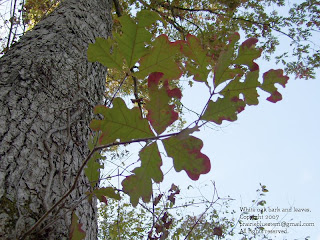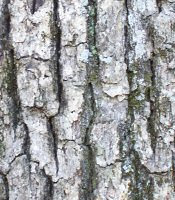Quercus alba, foliage and trunk
 One of the most helpful tree-identification things I've learned lately is that the sinuses of oak leaves at the top of the tree will be more deeply cut than those at the bottom of the tree. (Sinuses are the indentations between the lobes.) Apparently, a leaf that is getting plenty of sunshine doesn't need as much surface area as a leaf that is growing in the shade.
One of the most helpful tree-identification things I've learned lately is that the sinuses of oak leaves at the top of the tree will be more deeply cut than those at the bottom of the tree. (Sinuses are the indentations between the lobes.) Apparently, a leaf that is getting plenty of sunshine doesn't need as much surface area as a leaf that is growing in the shade.The white oak leaves in the image above are a good example. The leaves at the top of the tree (in the background at the top of the photo) have much deeper sinuses than those at the bottom of the tree (foreground.)
 White oak bark is quite distinctive in color. It's actually a light gray, not white, but it's lighter in color than many tree barks. It's often a bit scaly. You can see some scales on the trunk in the above photo at upper left.
White oak bark is quite distinctive in color. It's actually a light gray, not white, but it's lighter in color than many tree barks. It's often a bit scaly. You can see some scales on the trunk in the above photo at upper left.Recently, I happened to find a great image of white oak leaves and acorns from the early 1900s in the Kentucky Virtual Library. Its caption mentions that they came from "a monster white oak near Persimmon." Persimmon is a small settlement in Monroe County, Kentucky (north of Tompkinsville, in south central Kentucky.)

 "The power to recognize trees at a glance without examining their leaves or flowers or fruit as they are seen, for example, from the car-window during a railroad journey, can only be acquired by studying them as they grow under all possible conditions over wide areas of territory. Such an attainment may not have much practical value, but once acquired it gives to the possessor a good deal of pleasure which is denied to less fortunate travelers."
"The power to recognize trees at a glance without examining their leaves or flowers or fruit as they are seen, for example, from the car-window during a railroad journey, can only be acquired by studying them as they grow under all possible conditions over wide areas of territory. Such an attainment may not have much practical value, but once acquired it gives to the possessor a good deal of pleasure which is denied to less fortunate travelers."
0 comments -- please add yours:
Post a Comment